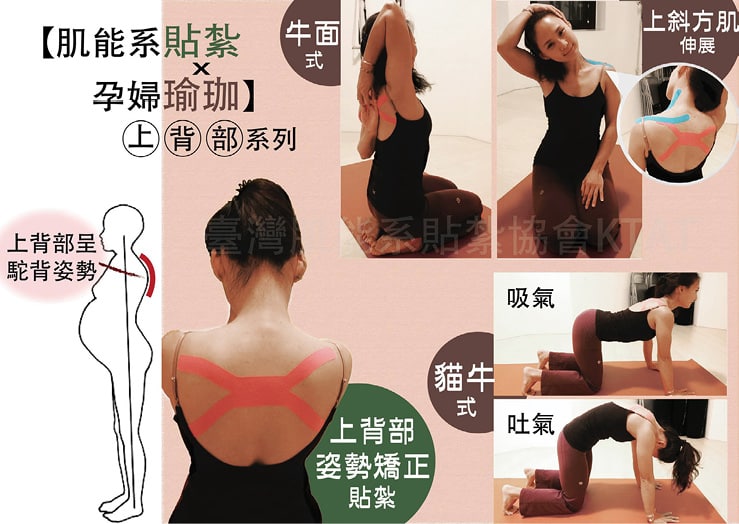During pregnancy, the expectant mother will be dealing with not only the weight of a new life, but also the attendant postural changes. As the baby grows, the body’s center of gravity may shift. The pelvic bones may move forward, causing excessive lumbar lordosis. In compensation the tendency may be to hunch the upper back to provide balance.
This in turn may weaken the support of the shoulders, neck and surrounding tissue in an unhealthy manner. A combination of Kinesio Taping and Yoga exercises may be used to relieve symptoms, increase spine mobility and correct posture.
Shown first is Kinesio Taping for upper back posture correction: Apply an X -strip to the midpoint of the back about even with the shoulder blades (leaving about 4 inches uncut in the center.) Fix the middle part of the tape with little or no tension between the shoulder blades and draw the end tails of the tape on both sides of the upper and lower edges of the scapula. Rub the tape gently to activate the adhesive.
The Cow Face pose will enable chest posture, but also can relieve upper back discomfort and tension . Next we present the Cow Face pose which will help to align the shoulders, hips and chest. From a kneeling position, raise the right arm and then bend at the elbow sharply bringing the right hand to the middle of the back. Place the left arm downward and bend at the elbow, bringing the left hand up to the mid back. Touch the hands together and pull, feeling the chest muscles and arm muscles slowly extended. You may adjust the distance between your hands; hold a towel between the hands if the fingers do not meet easily.

The next combination Kinesio Taping and stretch may help relieve pressure on the neck and shoulders and relieve neck pain caused by pregnancy. Tape the trapezius as shown and place one hand on the side of the head to help stretch the trapezius from the ear, gently down the side of the head applying backward and stopping for thirty seconds in the extended position.
All of these tapings and poses should be done gently and comfortably.

Whatever their physical condition, Sheryl notes, “people should not do activities that are painful or awkward, and instructors should not be pushing people beyond their limits. If one is in any class like that either quit or confront the instructor with your concerns.”
It isn’t a question of whether yoga or any other activity is inherently bad or good for you. “Extremes of any activity can be damaging.”





